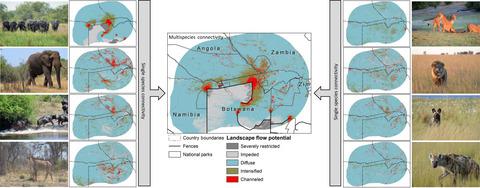当前位置:
X-MOL 学术
›
J. Appl. Ecol.
›
论文详情
Our official English website, www.x-mol.net, welcomes your feedback! (Note: you will need to create a separate account there.)
Characterizing multispecies connectivity across a transfrontier conservation landscape
Journal of Applied Ecology ( IF 5.7 ) Pub Date : 2020-08-20 , DOI: 10.1111/1365-2664.13716 Angela Brennan 1, 2, 3 , Piet Beytell 4 , Ortwin Aschenborn 5 , Pierre Du Preez 6 , Paul J. Funston 7 , Lise Hanssen 8 , J. W. Kilian 9 , Greg Stuart‐Hill 10 , Russell D. Taylor 10 , Robin Naidoo 1, 3
中文翻译:

跨境保护景观描述多物种的连通性
更新日期:2020-08-20
Journal of Applied Ecology ( IF 5.7 ) Pub Date : 2020-08-20 , DOI: 10.1111/1365-2664.13716 Angela Brennan 1, 2, 3 , Piet Beytell 4 , Ortwin Aschenborn 5 , Pierre Du Preez 6 , Paul J. Funston 7 , Lise Hanssen 8 , J. W. Kilian 9 , Greg Stuart‐Hill 10 , Russell D. Taylor 10 , Robin Naidoo 1, 3
Affiliation

|
- Connectivity conservation is aimed at sustaining animal movements and ecological processes important to ecosystem functioning and the maintenance of biodiversity. However, connectivity conservation plans are typically developed around a single species and rarely empirically evaluated for their relevance to others, thereby limiting our understanding of how connectivity requirements differ across species.
- We used an omnidirectional application of circuit theory and GPS data from six species to evaluate connectivity at multiple scales for multiple species within the world's largest transfrontier conservation landscape in southern Africa. We evaluated the effects of linear barriers, natural habitat types and anthropogenic land use on movement. We identified multispecies connectivity hotspots as areas where current flow was concentrated or channelled through pinch points. To evaluate surrogate species for connectivity, we evaluated the correspondence among single‐species connectivity across the entire landscape and also examined whether a more localized corridor for African savanna elephant Loxodonta africana captured high multispecies connectivity values.
- Connectivity models revealed many intact areas across the landscape with diffuse current flow, but also evidence that fences, rivers, roads and areas of anthropogenic use acted as strong barriers to movement—particularly in the case of fences, which completely blocked female elephant movement. Tests of correspondence among single‐species connectivity models revealed spotted hyaena and African wild dog as the strongest surrogate species of connectivity. Female elephants were found to be the weakest surrogate species of connectivity at the landscape scale. However, focusing within a localized elephant corridor revealed the areas of concentrated or channelled connectivity for most species in our study.
- Synthesis and applications. Our results suggest that the single‐species focus permeating connectivity literature may result in conservation plans that poorly conserve the connectivity needs of co‐occurring species. Our study also highlights the importance of testing the efficacy of surrogate species for connectivity at multiple scales. We recommend evaluating multispecies connectivity to prioritize areas for conservation that safeguard the connectivity needs of multiple species of conservation concern.
中文翻译:

跨境保护景观描述多物种的连通性
- 连通性保护旨在维持对生态系统功能和生物多样性维护至关重要的动物运动和生态过程。但是,连通性保护计划通常是围绕单个物种制定的,很少通过经验评估它们与其他物种的相关性,从而限制了我们对物种间连通性要求如何不同的理解。
- 我们使用了来自六个物种的电路理论和GPS数据的全方位应用,以评估南部非洲世界上最大的跨界保护景观内多个物种在多个尺度上的连通性。我们评估了线性障碍,自然栖息地类型和人为土地利用对运动的影响。我们将多物种连接热点确定为电流集中或通过夹点引导的区域。为了评估替代物种之间的连通性,我们评估了整个景观中单物种连通性之间的对应关系,还研究了非洲大草原象非洲象非洲象更本地化的走廊是否具有较高的多物种连通性值。
- 连通性模型揭示了整个地形中散布着大量电流的完整区域,但也有证据表明,围栏,河流,道路和人为使用区域是行动的强大障碍,尤其是在完全阻止雌象活动的围栏的情况下。单物种连通性模型之间的对应性测试显示,鬣狗和非洲野狗是连通性最强的替代物种。在景观尺度上,发现雌象是连通性最弱的替代物种。但是,在我们的研究中,将注意力集中在本地化的大象走廊上会发现大多数物种集中或引导连通的区域。
- 综合与应用。我们的研究结果表明,以单一物种为重点的渗透性连通性文献可能会导致制定的保护计划无法充分满足共生物种的连通性需求。我们的研究还强调了测试替代物种在多个规模上连通性的有效性的重要性。我们建议评估多物种的连通性,以区分保护区域的优先级,以保护多种保护物种的连通性需求。



























 京公网安备 11010802027423号
京公网安备 11010802027423号